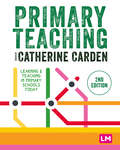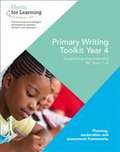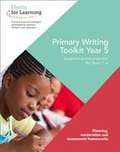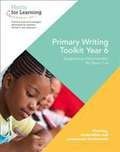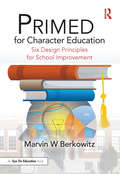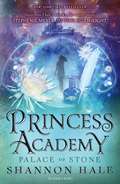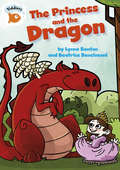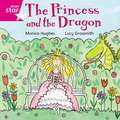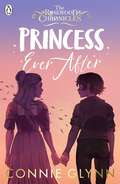- Table View
- List View
Primary Teaching: Learning and teaching in primary schools today (Primary Teaching Now)
by Catherine CardenThe second edition of this core text from Learning Matters asks: What is teaching? Does curriculum really matter? Does behaviour need ′managing′? What is a learning environment today? Does my classroom reflect the identities of all of my learners? How can I bring the theme of sustainability to my teaching? Discussing these and many more, it covers the contents of professional studies modules and goes beyond to support trainees on placements and in their learning on the course. Five new chapters are added for this edition discussing themes of sustainability, teacher self care, diversity in the curriculum, sex and relationships education and our new understanding of learning environments. Learning features throughout have been designed to help students develop their understanding, broaden their perspectives, think more critically and apply theory to practice. These include: Case Studies to apply learning to real-life school contexts. Key Readings to encourage wider reading, broaden perspectives and offer practical ideas for the classroom. Key Theory features introduce and summarise big ideas, theories and research. Critical Questions direct reflection, help students engage with what their reading and encourage critical responses. Classroom Links highlight good practice, provide practical ideas and show how to implement these in the classroom. Assignment features offer helpful points to consider and practical advice for writing assignments on chapter topics, which act as great starting points.
Primary Teaching: Learning and teaching in primary schools today (Primary Teaching Now)
by Catherine CardenThe second edition of this core text from Learning Matters asks: What is teaching? Does curriculum really matter? Does behaviour need ′managing′? What is a learning environment today? Does my classroom reflect the identities of all of my learners? How can I bring the theme of sustainability to my teaching? Discussing these and many more, it covers the contents of professional studies modules and goes beyond to support trainees on placements and in their learning on the course. Five new chapters are added for this edition discussing themes of sustainability, teacher self care, diversity in the curriculum, sex and relationships education and our new understanding of learning environments. Learning features throughout have been designed to help students develop their understanding, broaden their perspectives, think more critically and apply theory to practice. These include: Case Studies to apply learning to real-life school contexts. Key Readings to encourage wider reading, broaden perspectives and offer practical ideas for the classroom. Key Theory features introduce and summarise big ideas, theories and research. Critical Questions direct reflection, help students engage with what their reading and encourage critical responses. Classroom Links highlight good practice, provide practical ideas and show how to implement these in the classroom. Assignment features offer helpful points to consider and practical advice for writing assignments on chapter topics, which act as great starting points.
Primary Teaching: Learning and teaching in primary schools today (Primary Teaching Now)
The second edition of this core text from Learning Matters asks: What is teaching? Does curriculum really matter? Does behaviour need ′managing′? What is a learning environment today? Does my classroom reflect the identities of all of my learners? How can I bring the theme of sustainability to my teaching? Discussing these and many more, it covers the contents of professional studies modules and goes beyond to support trainees on placements and in their learning on the course. Five new chapters are added for this edition discussing themes of sustainability, teacher self care, diversity in the curriculum, sex and relationships education and our new understanding of learning environments. Learning features throughout have been designed to help students develop their understanding, broaden their perspectives, think more critically and apply theory to practice. These include: Case Studies to apply learning to real-life school contexts. Key Readings to encourage wider reading, broaden perspectives and offer practical ideas for the classroom. Key Theory features introduce and summarise big ideas, theories and research. Critical Questions direct reflection, help students engage with what their reading and encourage critical responses. Classroom Links highlight good practice, provide practical ideas and show how to implement these in the classroom. Assignment features offer helpful points to consider and practical advice for writing assignments on chapter topics, which act as great starting points.
Primary Teaching Skills
by Prof E Wragg E. C. WraggPrimary teachers have always been required to master a wealth of knowledge and professional skills and recent debate has led to pressure for ever higher levels of competence. Ted Wragg's book provides a comprehensive guide to the skills needed by today's primary teachers. Separate chapters cover such central demands of the job as explaining new topics, asking stimulating questions and settling down with a new class and one is devoted to the particular problems of supply teachers. Based on extensive research in classrooms over the last three years, Primary Teaching Skills will enlighten and entertain both student and novice teachers and their more experienced colleagues at all stages of their professional development.
Primary Teaching Skills
by Prof E Wragg E. C. WraggPrimary teachers have always been required to master a wealth of knowledge and professional skills and recent debate has led to pressure for ever higher levels of competence. Ted Wragg's book provides a comprehensive guide to the skills needed by today's primary teachers. Separate chapters cover such central demands of the job as explaining new topics, asking stimulating questions and settling down with a new class and one is devoted to the particular problems of supply teachers. Based on extensive research in classrooms over the last three years, Primary Teaching Skills will enlighten and entertain both student and novice teachers and their more experienced colleagues at all stages of their professional development.
Primary Teaching Today: An Introduction
by Denis HayesPrimary Teaching Today takes the reader ‘behind the scenes’ and alerts them to the fundamental attitudes and practices that every new primary teacher must acquire to make a success of their work and, crucially, to get maximum enjoyment while doing so. With a friendly narrative style and refreshing candour, the book focuses as much on what primary teachers should aspire to be as it does on what teachers are meant to do. Thus, the early chapters orientate towards the attributes for which teachers should persevere; the later chapters are more heavily weighted towards the implications for classroom practice and work in school. The final chapter offers a variety of exercises and tasks to deepen thinking and enhance professional learning, linked to the QTS Standards. Throughout the book there are ‘Extend your thinking’ prompts containing statements and questions to stimulate the reader in facing challenging issues, a ‘Terminology check’ to clarify meanings of terms, plus ‘Strengthening practice’ boxes with practical suggestions about implementation. The book is also unusual in that it provides relevant information about key issues under ‘Professional learning perspectives’ at the end of each chapter.
Primary Teaching Today: An Introduction
by Denis HayesPrimary Teaching Today takes the reader ‘behind the scenes’ and alerts them to the fundamental attitudes and practices that every new primary teacher must acquire to make a success of their work and, crucially, to get maximum enjoyment while doing so. With a friendly narrative style and refreshing candour, the book focuses as much on what primary teachers should aspire to be as it does on what teachers are meant to do. Thus, the early chapters orientate towards the attributes for which teachers should persevere; the later chapters are more heavily weighted towards the implications for classroom practice and work in school. The final chapter offers a variety of exercises and tasks to deepen thinking and enhance professional learning, linked to the QTS Standards. Throughout the book there are ‘Extend your thinking’ prompts containing statements and questions to stimulate the reader in facing challenging issues, a ‘Terminology check’ to clarify meanings of terms, plus ‘Strengthening practice’ boxes with practical suggestions about implementation. The book is also unusual in that it provides relevant information about key issues under ‘Professional learning perspectives’ at the end of each chapter.
Primary Writing Toolkit Year 4 (PDF)
by Herts for Herts for LearningImprove primary writing with robust planning, assessment and moderation across the school. This practical Toolkit supports subject leaders and teachers to set clear expectations for primary writing in each year group and to effectively monitor and evaluate progress. Are you a teacher or English subject lead looking to reboot writing in your class or school? This practical toolkit will help you set out your intent, implementation and impact for writing, and support you with planning, assessment and moderation across the school. You’ll be able to tailor teaching to children’s needs and your school curriculum, bringing in your own creative ideas and texts, around which to structure planning. This suite of documents provide structure, consistency and support for pitch and progression so children’s writing skills are systematically developed across the school. The Planning platforms are the starting place for year group teachers to plan for the teaching of writing. Teacher Assessment Frameworks are the finishing point for assessing attainment. The Progression Charts are supporting documents which group the objectives within the Planning Platforms so that progression across year groups and key stages can be seen for every objective. Bridging Documents form a further supporting document for each year group showing how the statements within the Planning Platform lead towards each ‘pupil can’ statement in the Teacher Assessment Framework. The Writing Toolkits also contain annotated portfolios of children’s work to support effective moderation, indicating features that exemplify pupils who are working at the expected standard for the year group. Used together, these resources result in an improved writing curriculum and clear expectations for primary writing in each year group.
Primary Writing Toolkit Year 5 (PDF)
by Herts for Herts for LearningImprove primary writing with robust planning, assessment and moderation across the school. This practical Toolkit supports subject leaders and teachers to set clear expectations for primary writing in each year group and to effectively monitor and evaluate progress. Are you a teacher or English subject lead looking to reboot writing in your class or school? This practical toolkit will help you set out your intent, implementation and impact for writing, and support you with planning, assessment and moderation across the school. You’ll be able to tailor teaching to children’s needs and your school curriculum, bringing in your own creative ideas and texts, around which to structure planning. This suite of documents provide structure, consistency and support for pitch and progression so children’s writing skills are systematically developed across the school. The Planning platforms are the starting place for year group teachers to plan for the teaching of writing. Teacher Assessment Frameworks are the finishing point for assessing attainment. The Progression Charts are supporting documents which group the objectives within the Planning Platforms so that progression across year groups and key stages can be seen for every objective. Bridging Documents form a further supporting document for each year group showing how the statements within the Planning Platform lead towards each ‘pupil can’ statement in the Teacher Assessment Framework. The Writing Toolkits also contain annotated portfolios of children’s work to support effective moderation, indicating features that exemplify pupils who are working at the expected standard for the year group. Used together, these resources result in an improved writing curriculum and clear expectations for primary writing in each year group.
Prime-Time Parenting: The Two-Hour-a-Day Secret to Raising Great Kids
by Heather MillerA two-hour school-night routine that helps parents support their children's social, emotional and intellectual development. School nights are a real challenge for most parents. Just as your energy flags, a slew of parenting duties looms ahead. Learn how to create a two-hour school night routine that works for both parent and child. By following this two-hour ritual, you'll be able to: Bond with your children Prepare and enjoy a nutritious dinner Support your child's organization and academic success Read with your child Follow a book-bath-bed routine to an early bedtime Enjoy some "me" time once the kids are in bedThe benefits of Prime-Time Parenting include better nutrition, better school performance, a more organized home, and well-rested parents and children. The hours between 6 and 8pm will never be the same!
PRIMED for Character Education: Six Design Principles for School Improvement
by Marvin W BerkowitzIn PRIMED for Character Education, renowned character educator Marvin W Berkowitz boils down decades of research on evidence-based practices and thought-provoking field experience into a clear set of principles that leaders, administrators, and teacher-leaders can implement to help students thrive. The author’s original six-component framework offers a comprehensive guide to shaping purposeful learning environments, healthy relationships, core values and virtues, role models, empowerment, and long-term development in any PreK-12 school or district. This engaging and heartfelt book features tips for practice, anecdotes from award-winning schools, and straightforward tenets from moral education, social-emotional learning, and positive psychology.
PRIMED for Character Education: Six Design Principles for School Improvement
by Marvin W BerkowitzIn PRIMED for Character Education, renowned character educator Marvin W Berkowitz boils down decades of research on evidence-based practices and thought-provoking field experience into a clear set of principles that leaders, administrators, and teacher-leaders can implement to help students thrive. The author’s original six-component framework offers a comprehensive guide to shaping purposeful learning environments, healthy relationships, core values and virtues, role models, empowerment, and long-term development in any PreK-12 school or district. This engaging and heartfelt book features tips for practice, anecdotes from award-winning schools, and straightforward tenets from moral education, social-emotional learning, and positive psychology.
A Primer On Environmental Decision-making: An Integrative Quantitative Approach
by Knut Lehre Seip Fred WenstøpA Primer on Minority Serving Institutions
by Andrés Castro Samayoa Marybeth GasmanMinority Serving Institutions (MSIs)—specifically Historically Black Colleges and Universities (HBCUs), Tribal Colleges and Universities (TCUs), Hispanic-Serving Institutions (HSIs), and Asian American and Native American Pacific Islander-Serving Institutions (AANAPISIs)—have carved out a unique niche in the nation, serving the needs of low-income, underrepresented students of color. Covering foundational topics relating to MSIs, chapter authors explore how salient issues across the landscape of higher education play out within the MSI context. Undergirded by national data and key literature, A Primer on Minority Serving Institutions provides graduate students, scholars, and researchers a full picture of the work and contributions of MSIs and urges them to think about MSIs as part of the larger higher education landscape.
A Primer on Minority Serving Institutions
by Andrés Castro Samayoa Marybeth GasmanMinority Serving Institutions (MSIs)—specifically Historically Black Colleges and Universities (HBCUs), Tribal Colleges and Universities (TCUs), Hispanic-Serving Institutions (HSIs), and Asian American and Native American Pacific Islander-Serving Institutions (AANAPISIs)—have carved out a unique niche in the nation, serving the needs of low-income, underrepresented students of color. Covering foundational topics relating to MSIs, chapter authors explore how salient issues across the landscape of higher education play out within the MSI context. Undergirded by national data and key literature, A Primer on Minority Serving Institutions provides graduate students, scholars, and researchers a full picture of the work and contributions of MSIs and urges them to think about MSIs as part of the larger higher education landscape.
A Primer on Theory in Architecture
by Karen Cordes SpenceA Primer on Theory in Architecture discusses how theory is defined in architecture, how it is identified, its location in larger perspectives or worldviews, its relationships to other areas in architecture, and how it can be constructed. The book explores the definition, elements and characteristics of theory along with subjects associated with theory and how these associations are recognized. In addition, case studies tackle both individual theorists and common approaches to the topic. Aimed at the new student of architectural theory, if you are just beginning to tackle this subject, begin with this book.
A Primer on Theory in Architecture
by Karen Cordes SpenceA Primer on Theory in Architecture discusses how theory is defined in architecture, how it is identified, its location in larger perspectives or worldviews, its relationships to other areas in architecture, and how it can be constructed. The book explores the definition, elements and characteristics of theory along with subjects associated with theory and how these associations are recognized. In addition, case studies tackle both individual theorists and common approaches to the topic. Aimed at the new student of architectural theory, if you are just beginning to tackle this subject, begin with this book.
Primitive Photography: A Guide to Making Cameras, Lenses, and Calotypes
by Alan GreenePrimitive Photography considers the hand-made photographic process in its entirety, showing the reader how to make box-cameras, lenses, paper negatives and salt prints, using inexpensive tools and materials found in most hardware and art-supply stores. Step-by-step procedures are presented alongside theoretical explanations and historical background. Streamlined calotype procedures are demonstrated, featuring different paper negative processes and overlooked, developing-out printing methods. Primitive Photography combines the simplicity of pinhole photography, the handmade quality of alternative processes, and the precision of large-format. For those seeking alternatives to commercially prepared material as well as digital photography, it provides the instructions for creating the entire photographic process from the ground up. Given its scope and treatment of the photographic process as a whole, this may be the first book of its kind to appear in over a century.
Primitive Photography: A Guide to Making Cameras, Lenses, and Calotypes (Alternative Process Photography Ser.)
by Alan GreenePrimitive Photography considers the hand-made photographic process in its entirety, showing the reader how to make box-cameras, lenses, paper negatives and salt prints, using inexpensive tools and materials found in most hardware and art-supply stores. Step-by-step procedures are presented alongside theoretical explanations and historical background. Streamlined calotype procedures are demonstrated, featuring different paper negative processes and overlooked, developing-out printing methods. Primitive Photography combines the simplicity of pinhole photography, the handmade quality of alternative processes, and the precision of large-format. For those seeking alternatives to commercially prepared material as well as digital photography, it provides the instructions for creating the entire photographic process from the ground up. Given its scope and treatment of the photographic process as a whole, this may be the first book of its kind to appear in over a century.
Princess Academy: New Edition (Princess Academy Ser. #2)
by Shannon HaleThis long-awaited follow-up to Newbery Honor winner Princess Academy hit the New York Times bestseller list in the first week of US publication. A rich and compelling fantasy about one girl's journey to discover where her home and heart truly belong in a divided world is reminiscent of the best writing by authors like Eva Ibbotson and Cornelia Funke.With a chance to study at the university and live at the Queen's Castle, Miri leaves village life and is thrust into the bustling chaos of the city. Her best friend, Britta, has been chosen by the Prince of Asland to be his bride, and the royal wedding is fast approaching. But helping Britta prepare for her future is not an easy task. When Miri discovers a secret plot against the royal court - which is motivated by good - she feels torn. Will she choose loyalty to the princess, or reform for the people? As Miri struggles to resolve this dilemma in her own mind, her heart is suffering: an old love comforts her; a new crush consumes her; she yearns for her homeland. Can Miri find her way in this new place, or will she be considered a traitor? The fate of the kingdom is at stake.
The Princess and the Dragon: The Princess And The Dragon (library Ebook) (Tiddlers #22)
by Lynne BentonThe princess has a very unusual best friend ... a fire-breathing dragon! A Prince passing by stops to rescue the princess but soon realises he is not needed! The Tiddlers series features fun stories with a word count of fewer than 50 words for children who are just starting to read. A word list at the beginning of the story allows for a quick check of the reader's ability to read and understand words before reading, and a puzzle at the end of the story encourages rereading for pleasure.
The Princess and the Dragon (Rigby Rocket #Pink Reader 12)
by Monica HughesWhat will happen when the princess and the dragon meet?
The Princess and the Dragon (Rigby Rocket #Pink Reader 12)
by Monica HughesWhat will happen when the princess and the dragon meet?
Princess Ever After (The Rosewood Chronicles)
by Connie GlynnReturn to the magical world of The Rosewood Chronicles in the fifth and final instalment of this gorgeous series for fans of The Princess Diaries and Harry Potter. Ellie is a rebellious princess who is no longer hiding her real identity. Lottie is her Portman, wishing that she could shield Ellie from the threat of Leviathan. Jamie is Ellie's Partizan, a lifelong bodyguard sworn to protect the princess at any cost - but has mysteriously disappeared. Not all of the trio have made it back to Rosewood Hall. Can they be reunited? And at what cost?With the crown at risk, the stakes have never been higher . . . --------------------------------------------------------------------------- Praise for Undercover Princess: 'With a fake princess, a rogue royal and fairytale twists aplenty, this is the start of a fun new series' - The Sun 'Once Upon A Time fans will love this new book' - Buzzfeed 'The book is a great example of friendship and bravery' - First News 'A fun blend of school story, adventure and mystery' - Week Junior
